|
|
|
Sort Order |
|
|
|
Items / Page
|
|
|
|
|
|
|
| Srl | Item |
| 1 |
ID:
090061
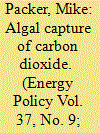

|
|
|
|
|
| Publication |
2009.
|
| Summary/Abstract |
The use of algae to capture carbon dioxide as a method for greenhouse gas mitigation is discussed. A small fraction of the sunlight energy that bathes Earth is captured by photosynthesis and drives most living systems. Life on Earth is carbon-based and the energy is used to fix atmospheric carbon dioxide into biological material (biomass), indeed fossil fuels that we consume today are a legacy of mostly algal photosynthesis. Algae can be thought of as marine and freshwater plants that have higher photosynthetic efficiencies than terrestrial plants and are more efficient capturing carbon (Box 1). They have other favourable characteristics for this purpose. In the context of New Zealand energy strategy and policy I discuss progress in growing algae and seaweeds with emphasis on their application for exhaust flue carbon recycling for possible generation of useful biomass. I also introduce schemes utilising wild oceanic algae for carbon dioxide sequestration and the merits and possible adverse effects of using this approach. This paper is designed as an approachable review of the science and technology for policy makers and a summary of the New Zealand policy environment for those wishing to deploy biological carbon sequestration.
|
|
|
|
|
|
|
|
|
|
|
|
|
|
|
|
| 2 |
ID:
090075
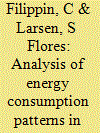

|
|
|
|
|
| Publication |
2009.
|
| Summary/Abstract |
This paper analyzes the energy consumption during the period 2001-2006 of 192 flats distributed in three-storey buildings, in order to understand how current policies related to energy use could be improved for increased residential energy efficiency in Argentina. The buildings (1, 2 and 3 bedrooms) are located in La Pampa, central Argentina, in a moderate cold climate. The dimensional and energy-consumption variables are studied (area, envelope's area, FAEP=envelope's area/floor area; envelope's thermal resistance R, volumetric heat loss G and auxiliary heating Qaux). The natural gas consumption is analyzed at annual and seasonal levels. Consumption variability among buildings, storeys and flats is calculated. The quantitative analysis is coupled to a qualitative description through direct observation of the buildings. The results show: (a) a high incidence of natural gas consumption in the total annual energy consumption (natural gas+electricity), (b) seasonality of natural gas consumption, with a maximum value in the cold period July-August (variability=80%), (c) little variability among buildings of the annual natural gas consumption (4.17%), (d) the lowest average energy consumption at the first floor, (e) high variability among flats on each storey, (f) winter consumption of a multi-family dwelling lower than a single-family dwelling of similar area and (g) little seasonal variability of the electricity consumption.
|
|
|
|
|
|
|
|
|
|
|
|
|
|
|
|
| 3 |
ID:
090105
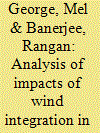

|
|
|
|
|
| Publication |
2009.
|
| Summary/Abstract |
As the share of wind in power systems increases, it is important to assess the impact on the grid. This paper combines analysis of load and generation characteristics, generation adequacy and base and peak load variations to assess the future role of wind generation. A simulation of Tamil Nadu in India, with a high penetration of wind power (27% by installed capacity), shows a capacity credit of 22% of the installed wind capacity. For seasonal wind regimes like India, neither the capacity factor, nor the capacity credit reflects the monthly variation in the wind generation. A new approach based on the annual load duration curve has been proposed for generation expansion planning with higher penetration of wind. The potential savings in base and peak capacity required with increasing wind power have been quantified. A future scenario for Tamil Nadu for 2021 has been illustrated. It was found that 5500 MW of wind power can save 3200 MU of peak energy required or an average peak capacity of 2400 and 1100 MW of base capacity. This analysis would be useful to assess the future impacts of increasing wind capacity in grids.
|
|
|
|
|
|
|
|
|
|
|
|
|
|
|
|
| 4 |
ID:
090083


|
|
|
|
|
| Publication |
2009.
|
| Summary/Abstract |
Market efficiency is analysed for the Iberian Power Futures Market and other European Power Markets, as well as other fuel markets through evaluation of ex-post Forward Risk Premium. The equilibrium price from compulsory call auctions for distribution companies within the framework of the Iberian Power Futures Market is not optimal for remuneration purposes as it seems to be slightly upward biased. In the period considered (August 2006-July 2008), monthly futures contracts behave similarly to quarterly contracts. Average risk premia have been positive in power and natural gas markets but negative in oil and coal markets. Different hypotheses are tested regarding increasing volatility with maturity and regarding Forward Risk Premium variations (decreasing with variance of spot prices during delivery period and increasing with skewness of spot prices during delivery period). Enlarged data sets are recommended for stronger test results. Energy markets tend to show limited levels of market efficiency. Regarding the emerging Iberian Power Futures Market, price efficiency is improved with market development of all the coexistent forward contracting mechanisms and with further integration of European Regional Electricity Markets.
|
|
|
|
|
|
|
|
|
|
|
|
|
|
|
|
| 5 |
ID:
090079


|
|
|
|
|
| Publication |
2009.
|
| Summary/Abstract |
Electricity sector is among the key users of natural gas. The sustained electricity deficit and environment policies have added to an already rising demand for gas. This paper tries to understand gas demand in future from electricity sector. This paper models the future demand for gas in India from the electricity sector under alternative scenarios for the period 2005-2025, using bottom-up ANSWER MARKAL model. The scenarios are differentiated by alternate economic growth projections and policies related to coal reforms, infrastructure choices and local environment. The results across scenarios show that gas competes with coal as a base-load option if price difference is below US $ 4 per MBtu. At higher price difference gas penetrates only the peak power market. Gas demand is lower in the high economic growth scenario, since electricity sector is more flexible in substitution of primary energy. Gas demand reduces also in cases when coal supply curve shifts rightwards such as under coal reforms and coal-by-wire scenarios. Local environmental (SO2 emissions) control promotes end of pipe solutions flue gas de-sulfurisation (FGD) initially, though in the longer term mitigation happens by fuel substitution (coal by gas) and introduction of clean coal technologies integrated gasification combined cycle (IGCC).
|
|
|
|
|
|
|
|
|
|
|
|
|
|
|
|
| 6 |
ID:
090034


|
|
|
|
|
| Publication |
2009.
|
| Summary/Abstract |
Carbon capture and storage (CCS) is considered a leading technology for reducing CO2 emissions from fossil-fuelled electricity generation plants and could permit the continued use of coal and gas whilst meeting greenhouse gas targets. However considerable energy is required for the capture, compression, transport and storage steps involved. In this paper, energy penalty information in the literature is reviewed, and thermodynamically ideal and "real world" energy penalty values are calculated. For a sub-critical pulverized coal (PC) plant, the energy penalty values for 100% capture are 48.6% and 43.5% for liquefied CO2, and for CO2 compressed to 11 MPa, respectively. When assumptions for supercritical plants were incorporated, results were in broad agreement with published values arising from process modelling. However, we show that energy use in existing capture operations is considerably greater than indicated by most projections. Full CCS demonstration plants are now required to verify modelled energy penalty values. However, it appears unlikely that CCS will deliver significant CO2 reductions in a timely fashion. In addition, many uncertainties remain over the permanence of CO2 storage, either in geological formations, or beneath the ocean. We conclude that further investment in CCS should be seriously questioned by policy makers.
|
|
|
|
|
|
|
|
|
|
|
|
|
|
|
|
| 7 |
ID:
090063


|
|
|
|
|
| Publication |
2009.
|
| Summary/Abstract |
International air transport emissions are not subject to liability under the Kyoto Protocol. However, pressure is mounting globally for international aviation to be included in post-Kyoto arrangements. In the absence of international collective action, a number of so-called carbon offsetting schemes have emerged that allow individual travellers and companies to compensate for their international air travel emissions. These schemes offer technological solutions, such as planting sink forests to sequester emissions. To consider the implications of future collective action, this paper presents a case study assessment of the physical feasibility of five schemes for all short duration journeys to and from New Zealand. This is the first comprehensive national-level case study assessment of competing offsetting options for international aviation emissions in the peer-reviewed literature. The CO2-e emissions produced by the air travel of international visitors to New Zealand, and for New Zealand residents travelling overseas, is calculated in this paper to be 7893 and 3948 Gg, respectively, in 2005. It is then shown that no single offsetting scheme targeted inside the country appears physically and/or politically realistic. This indicates the sheer size of these emissions, and the challenge that the international community faces for collective action on this matter.
|
|
|
|
|
|
|
|
|
|
|
|
|
|
|
|
| 8 |
ID:
090082
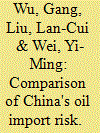

|
|
|
|
|
| Publication |
2009.
|
| Summary/Abstract |
In recent years, the international oil price has fluctuated violently, bringing about huge risk for the international oil trade. In fact, the risk of crude oil and petroleum product imports is different because of the different import origins and prices. Which import risk is lower for China? From the perspective of oil supply security, how should China portfolio crude oil and petroleum product imports to minimize its oil import risk? Using portfolio theory and a diversification index approach, this paper compares and analyzes the supply, price and transport risks of crude oil and petroleum product imports. Our results show that the following: (1) Specific risk (diversification risk) and marine transport risk of China's petroleum product imports are lower than that of crude oil imports. (2) The average rate of return of China's petroleum product imports is higher than that of crude oil imports. Moreover, the average import price variance of petroleum product imports is lower than that of crude oil imports. Thus, the systematic risk (price risk) of petroleum products is lower too. Therefore, from the perspective of oil supply security, China should increase petroleum product imports to decrease its oil import risk.
|
|
|
|
|
|
|
|
|
|
|
|
|
|
|
|
| 9 |
ID:
090055


|
|
|
|
|
| Publication |
2009.
|
| Summary/Abstract |
The establishment of a compressed air system (CAS) best practice programme is a key component of one of the initial industrial energy efficiency programmes being driven by New Zealand government ministries and agencies. In a global context this is not a new initiative in that existing programmes have been functioning in Europe and USA, yet in each of these cases the impact ten years-on has been patchy with limited long-term improvements in overall energy efficiency. The New Zealand CAS best practice programme currently under development is sponsored by the Electricity Commission (EC) and the Energy Efficiency Conservation Authority (EECA). It takes a new approach in policy direction, with variations from those used in other international programmes. A significant level of electricity levy money is to be committed to this programme and it is timely to highlight its merits and potential weaknesses, and what is required to generate long-term energy savings beyond the levels achieved by more mature overseas programmes.
|
|
|
|
|
|
|
|
|
|
|
|
|
|
|
|
| 10 |
ID:
090070


|
|
|
|
|
| Publication |
2009.
|
| Summary/Abstract |
Electric motors are a major energy-consuming appliance in the industrial sector. According to a survey, electric motors account for more than 70% of the total growth from 1991 to 2004 in electricity consumption in this sector in Malaysia. To reduce electricity consumption, Malaysia should consider resetting the minimum energy efficiency standards for electric motors sometime in the coming year. The first step towards adopting energy efficiency standards is the creation of a procedure for testing and rating equipment. An energy test procedure is the technical foundation for all energy efficiency standards, energy labels and other related programs. The test conditions in the test procedure must represent the conditions of the country. This paper presents the process for the selection of an energy test procedure for electric motors in Malaysia based on the country's conditions and requirements. The adoption of test procedures for electric motors internationally by several countries is also discussed in this paper. Even though the paper only discusses the test procedure for electric motors in Malaysia, the methods can be directly applied in other countries without major modifications.
|
|
|
|
|
|
|
|
|
|
|
|
|
|
|
|
| 11 |
ID:
090088


|
|
|
|
|
| Publication |
2009.
|
| Summary/Abstract |
Since 1990, effective support schemes for renewable energies have been introduced mainly in European countries. In this article, the authors explain which consequences different general conditions could have on the design and functioning of feed-in laws. Cornerstones for an adjusted feed-in law to the particular general conditions of emerging and developing countries in South America will be drawn, which should give support to the decision-makers for designing an attuned and well-functioning feed-in legislation.
|
|
|
|
|
|
|
|
|
|
|
|
|
|
|
|
| 12 |
ID:
090069


|
|
|
|
|
| Publication |
2009.
|
| Summary/Abstract |
On March 10, 2009, the US Environmental Protection Agency (EPA) proposed a new rule, Mandatory Reporting of Greenhouse Gases. When final, the rule would compel most large sources of greenhouse gases (GHGs) to report their emissions to EPA as well as fossil fuel suppliers and vehicle engine manufacturers to report their fuel sales and engine emissions rates, respectively. We suggest a number of improvements to the rule that would enhance compatibility with expected future climate legislation and enable a broader range of policies and analysis: (1) lower the threshold for reporting to a level more consistent with expected future legislation, (2) require reporting of electricity use along with direct emissions, (3) require reporting of emissions per unit output for a small number of selected sectors, (4) include a system of identifying corporate ownership of reporting facilities, and (5) identify a path toward coverage for sectors that were left out of the proposal due to underdeveloped reporting protocols.
|
|
|
|
|
|
|
|
|
|
|
|
|
|
|
|
| 13 |
ID:
090076


|
|
|
|
|
| Publication |
2009.
|
| Summary/Abstract |
In Norway there is a growing concern that electricity production and transmission may not meet the demand in peak-load situations. It is therefore important to evaluate the potential of different demand-side measures that may contribute to reduce peak load. This paper analyses data from an experiment where residential water heaters were automatically disconnected during peak periods of the day. A model of hourly electricity consumption is used to evaluate the effects on the load of the disconnections. The results indicate an average consumption reduction per household of approximately 0.5 kWh/h during disconnection, and an additional average increase in consumption the following hour, due to the payback effect, that may reach up to 0.28 kWh/h per household.
|
|
|
|
|
|
|
|
|
|
|
|
|
|
|
|
| 14 |
ID:
090043


|
|
|
|
|
| Publication |
2009.
|
| Summary/Abstract |
If future climate change goals being negotiated internationally are to have any chance of being achieved, developed countries need to undertake a major transition in their energy systems. This will require a rapid expansion of renewable energy generation, including wind electricity. Wind energy in New Zealand is commercially viable in many cases, yet opportunities for its exploitation are far from fully utilised. Many communities are showing resistance to wind farm developments, since large wind farms are often seen as intrusive. Building wind farms on a small scale may be a useful way of overcoming this problem.
This study examines the pattern of recent wind industry development in New Zealand. It is argued that two key characteristics have emerged that are limiting the potential development of the industry: a trend towards large scale, leading to increased local opposition; and a small number of investors. Research methods include a review of international and local literature, and a rural mail survey questionnaire, with 338 respondents. We provide survey evidence that small wind farms, and community ownership of them, may be attractive to local communities, and that this point of advantage is helpful for the rapid expansion of wind generation in New Zealand.
|
|
|
|
|
|
|
|
|
|
|
|
|
|
|
|
| 15 |
ID:
090039
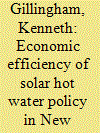

|
|
|
|
|
| Publication |
2009.
|
| Summary/Abstract |
New Zealand has recently followed the path of several other countries in promoting solar hot water (SHW) systems in the effort to reduce greenhouse gas emissions, yet the economic efficiency of large-scale policies to encourage SHW remains a pressing question for policymakers. This paper develops an economic framework to examine policies to promote SHW in New Zealand, including the current information, training, and subsidy policy. The economic framework points to environmental, energy security, and average-cost electricity retail pricing market failures as motivation for SHW policy, with the global climate change externality the most important of these. The results indicate that domestic SHW systems are close to being financially attractive from a consumer perspective, but a more substantial subsidy policy would be necessary for SHW to appeal to a wider audience. Such a policy is far more likely to have positive net benefits than a policy of mandating SHW on all homes or all new homes in New Zealand, and could be justified on economic efficiency grounds under reasonable assumptions. However, this result reverses under an economy-wide carbon trading system that internalizes the environmental externality.
|
|
|
|
|
|
|
|
|
|
|
|
|
|
|
|
| 16 |
ID:
090047


|
|
|
|
|
| Publication |
2009.
|
| Summary/Abstract |
Geothermal power is an important part of New Zealand's renewable electricity supply due to its attractive cost and reliability. Modular type binary cycle plants have been imported and installed in various geothermal fields in New Zealand, with plans for further expansion. Power output of these plants deteriorates in the summer because plant efficiency depends directly on the geothermal resource and the ambient temperature. As these plants normally use air-cooled condensers, incorporating a water-augmented air-cooled system could improve the power output in summer thereby matching the peak air-conditioning demand. In this work, power generation for the Rotokawa plant was characterized using a similar plant performance and local weather. The improved performance was modelled for retrofit with a wet-cooling system. Maximum generation increase on the hottest day could be 6.8%. The average gain in power over the summer, November-February, was 1.5%, and the average gain for the whole year was 1%. With current binary unit generation capacity at the Rotokawa plant of 35 MW, investment in a water-augmented air-cooled system could provide 2 MW of peak generation on the hottest days. This investment in efficiency is found to compare favourably to other supply options such as solar PV, wind or gas.
|
|
|
|
|
|
|
|
|
|
|
|
|
|
|
|
| 17 |
ID:
090100


|
|
|
|
|
| Publication |
2009.
|
| Summary/Abstract |
Distributed generation units are desirable from an environmental point of view but also have an impact on the costs of electricity grids at the distribution and transmission level. Therefore, investment planning has to consider all benefits and costs of DG to build DG sources at sites where they are economically efficient. Unfortunately, this is not an easy task in an unbundled industry where distribution and generation of electricity are not planned by one single institution. For this reason, this article analyses possible policy options for giving incentives to distributed generation and focuses on the long-term investment signals related to DG.
|
|
|
|
|
|
|
|
|
|
|
|
|
|
|
|
| 18 |
ID:
090096
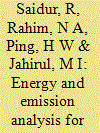

|
|
|
|
|
| Publication |
2009.
|
| Summary/Abstract |
The industrial sector is the largest user of energy in Malaysia. Industrial motors account for a major segment of total industrial energy use. Since motors are the principle energy users, different energy savings strategies have been applied to reduce their energy consumption and associated emissions released into the atmosphere. These strategies include using highly efficient motors, variable speed drive (VSD), and capacitor banks to improve the power factor. It has been estimated that there can be a total energy savings of 1765, 2703 and 3605 MWh by utilizing energy-efficient motors for 50%, 75% and 100% loads, respectively. It was also found that for different motor loads, an estimated US$115,936 US$173,019 and US$230,693 can be saved in anticipated energy costs. Similarly, it is hypothesized that a significant amount of energy can be saved using VSD and capacitor banks to reduce speed and improve the power factor, thus cutting energy costs. Moreover, a substantial reduction in the amount of emissions can be effected together with the associated energy savings for different energy savings strategies. In addition, the payback period for different energy savings strategies has been found to be reasonable in some cases.
|
|
|
|
|
|
|
|
|
|
|
|
|
|
|
|
| 19 |
ID:
090071


|
|
|
|
|
| Publication |
2009.
|
| Summary/Abstract |
Unlike the manufacturing sector, the residential/commercial sectors of Japan struggle to meet their environmental requirements. For instance, their CO2 emission levels have increased tremendously since 1990. This research estimates energy and 'exergy (available energy)' efficiencies in Japan's residential/commercial sectors during the period 1990-2006. Since an exergy analysis reveals 'available energy losses', it is an effective tool to achieve sustainable societies. The primary objective of this paper is to examine the potential for advancing the 'true' energy efficiency in Japan's residential/commercial sectors-by observing energy and exergy efficiency disparities. The results show large differences between the overall energy and exergy efficiencies in the residential (60.12%, 6.33%)/commercial sectors (51.78%, 5.74%) in 2006. This implies great potential for energy savings in both sectors. Furthermore, this research suggests that the residential sector may face more difficulties than the commercial sector, although the latter appears to be less energy-efficient, according to recent statistics. This is because the disparity between energy and exergy efficiencies has expanded in the residential sector since 2000. This study illustrates the importance of exergy analyses in promoting sustainable energy policies and new adaptation strategies.
|
|
|
|
|
|
|
|
|
|
|
|
|
|
|
|
| 20 |
ID:
090091


|
|
|
|
|
| Publication |
2009.
|
| Summary/Abstract |
Rice is the major staple food in most Asian countries. However, with rapidly growing populations, sustained high productivity and yields through improving water productivity is critically important. Increasingly complex energy-agriculture relationships require an in-depth understanding of water and energy tradeoffs. This study contributes to energy and food policies by analysing the complex energy, water and economics dynamics across a selection of major rice growing countries.
The results show that tradeoffs exist between yield and energy inputs with high yield attributed to higher levels of energy input. The selected developed countries show higher energy productivity, relative to all other energy inputs, compared to the selected developing counties, owing to enhanced mechanisation, on-farm technology and improved farm management. Among all countries, China has the highest water productivity due to water-saving irrigation practices. These practices offer opportunities for developed and developing countries to increase water productivity at the same time taking advantage of economic and energy benefits of reduced pumping.
Sustained production from agriculture is vital to food security. Improved irrigation practices can offset environmental footprints in the short run but their large-scale implementation remains an issue. In the long run, investments are needed to buffer the negative impacts of food production on the environment. Investments to boost water productivity and improved energy use efficiency in crop production are two pathways to reduce energy dependency, enhanced natural resource sustainability and ensuring future food security.
|
|
|
|
|
|
|
|
|
|
|
|
|
|
|
|
|
|
|
|
|